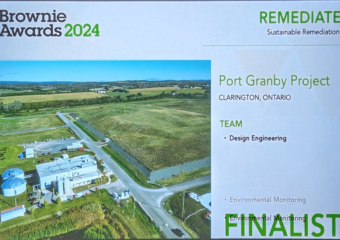Hydraulic hoses are frequently used in the course of Port Hope Area Initiative (PHAI) work in many types of construction equipment and vehicles. The hose ensures that oil flows freely between pieces that keep the hydraulic system moving and machine operating efficiently and effectively. Failure or breakage of a hose during operation can result in the spill of hydraulic oil.
In the event of a spill, workers will immediately take action to control and clean up the spill, often using absorbent pads designed specifically for construction work. “The good news is the majority of the hydraulic oil used on our projects is biodegradable, especially in machinery near sensitive receptors such as water or other potential wildlife habitat. ” said Carrie Ann Bray, Environmental Assessment Follow-up Program Specialist “CNL contractors use hydraulic fluid that would be the least harmful to the environment in the event of an accidental spill.”
The most common cause of hydraulic hose failure is abrasion, which occurs when the outer cover of a hose is worn away, and can result in leaking. Cracks are also a regular sign that a hydraulic hose is aging, as they are caused by normal use or from exposure to sun and heat. When placing hoses on machinery, technicians plan the routing that will cause the least amount of abrasions or bends. With proper use and care hydraulic hoses can last for up to five years.
CNL and our contractors understand preventative maintenance and regular inspections are key to minimizing hydraulic hose failures before they occur. Inspections identify hoses that are showing signs of abrasion or cracking to prompt replacement. The majority of hydraulic hose failures can be identified and mitigated through routine inspections and preventative maintenance.
“CNL contractors perform daily pre-use inspections on equipment which includes a visual inspection of hydraulic hoses. During these inspections if a hydraulic hose or other component of the equipment is identified as being damaged the equipment is taken out of service and repaired.” said Jordan Wilson, Manager of Construction Oversight for the PHAI. “These inspections and actions are part of multiple contractor plans, including the Spill Prevention and Response Plan or Health and Safety Plan (HASP).”
CNL is committed to completing all project work safely with focus on the protection of our workers, the public and the environment.


